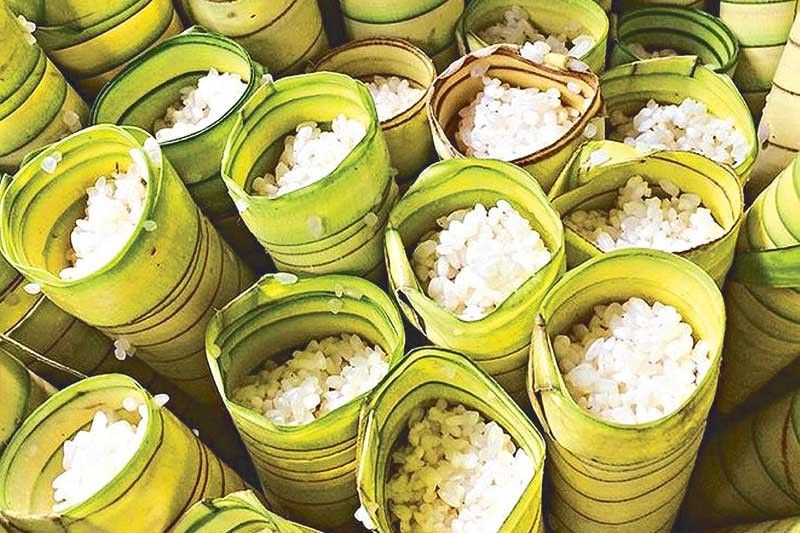Suman for the saints & souls


Phantom-like smoke billows from the makeshift stove that rests in a corner in our backyard in Gulod. Atop the stove, made up of three hollow blocks arranged like a triangle, is a boiling kawa (vat) filled with suman sa buli. The firewood under it hisses in orange flames. The crackling and hissing of the firewood is unabated for seven hours. Yet for another hour, the cooking continues; this time the flames are less, with just the embers in their reddish glory.
Yes, a maximum of eight hours is how long my Nanay cooks the suman, a kind of rice cake made from glutinous rice that is drenched in coconut milk and wrapped in buli palm. It’s backbreaking to cook suman but my mother will not let All Saints’ Day pass without suman on our table. She cooks the suman on Oct. 31 in preparation for the observance of All Saints’ Day on Nov. 1. (When my father was still alive, he and my mother were a tandem till the wee hours cooking suman. They would serenade each other in the hammock under the himbaba-o tree as they added firewood in the makeshift stove or water to the vat.)
In our house in Gulod — and in other houses in the neighborhood and in other coastal barangays in Cabuyao — no All Saints’ Day will pass without homemade suman. According to my mother, she grew up to the tradition of giving suman to the mangangaluluwa or carollers during All Saints’ Day. (To this day, she calls it Undras and not the popular term Undas.)
The suman sa buli at home is not just a scrumptious delicacy we dip in white sugar but also an art that is as laborious as it is arduous to prepare.
A day before the cooking ceremony, the kampil (small tubular containers made of buli leaves) is prepared. When we were kids, we would get the buli from our backyard. But now, Nanay buys it from the market and she chooses the best unopened frond the way a jeweler scrutinizes the best diamond in a lot.
At 74, she opens the frond with her hands and with a sharp knife she separates the leaflets. The stick in the midsection of the leaflets is used to stitch up the kampil. You should see how she coils the kampil; it is an art in itself. Not too tight, not too loose. She arranges the tubular containers in a batya (tub) and covers them with a wet katsa (cheesecloth) so they will not wilt overnight.
The following day, with excitement on her face, she is ready to prepare the suman. She’s a purist; she does not want too many hands helping her when she prepares the suman.
My mother, a farmer in her prime, knows the best malagkit (glutinous rice) to use — sungsong. She washes the rice and let it dry in a batya. When it is dry, she pours liters and liters of kakang gata (coconut cream). She showers it with salt. She knows by heart how to mix the ingredients — no measurement needed.
She scoops the rice onto the kampil. One by one. She hums her favorite kundiman as she does it. She lines them up in another tub, making sure they will not spill. When all containers are filled, she gathers the scraps of the fronds and turn them into strings. She runs the improvised string around the kampil oozing with malagkit drenched in gata.
When she’s done stringing up each suman, she gingerly puts them in a vat one by one. So the suman will not stick to the bottom of the vat when they are being cooked, my mother layers the kawa first with the remaining buli scraps. Then my Kuya Ronnie will pour pails of water into the vat. My mother covers the suman with a cheesecloth before putting the vat’s lid. The cooking begins when the firewood — from our kamalig — is set on fire.
I have to mention that months before Oct. 31 approaches, we already have a stock of firewood in our kamalig. There was a time when we would make our own firewood from the Sta. Elena trees in our backyard. (Sta. Elena, according to my father, is a variety of ipil-ipil that has a wide trunk and big branches). Of late, my mother buys way in advance the stacks of firewood and keep them in the kamalig to make sure they are indeed dry when the time comes for her to cook the suman.
I once suggested to my mother to cook the suman using LPG and she just gave me a short reply: “Maiiba ang lasa.” I never mentioned LPG again to her when she cooks suman at home. (We don’t even have a pressure cooker at home because, as my mother says, “Malansa ang karne kapag mabilisang pinalambot.” We also don’t have a microwave oven because my mother does not believe in instant heating of food.)
So, it is always firewood that she uses to cook her suman. She stares at the fire that licks the sides of the vat with happiness. For her children and grandchildren, even if it is tedious, she will make suman for them. When she hears the vat boiling, joy runs through her face. A few minutes after, she tells my Kuya, “Bantuan mo na (You may now add water to the vat).” And every 30 minutes or so, even without looking at the clock, for eight hours, she tells my brother, “Bantuan mo na ulit (Add water again).”
When the night is quiet and only the crackling of the firewood is heard, it is one of the moments when I see my mother happiest. The glow of the fire under the vat is illuminated on her beautiful face as she sits a few meters away from the stove. She turns reflective many times. “Even if we didn’t have much in the past, there was no Undras that we did not have suman.”
For my parents, the suman symbolized their will to survive many a hardship of life. They did not buy the malagkit then because they were farmers who knew how to keep the best rice variety. The coconuts used in making the suman were from our trees. Even the buli and firewood were from our yard. The suman was our parents’ way of telling their five children that despite our many wants in life, we could celebrate life still, with suman sa buli aplenty on our table.
That the making of the suman is both labor and flavor of love is seen further when it is cooked. After two to three taste tests by my mother in the last hour of cooking, she declares the suman ready to eat. Using a ladle, Kuya Ronnie hauls the suman from the vat to a tub. A freshly cooked suman is very sticky to the hands so, even if it is still hot, my mother and her children will wipe the suman using a cheesecloth. Then we eat suman to our heart’s content. A celebration begins in the middle of the night.
And it is still the same celebration that we feel now as Nanay fills up our appetite with suman sa buli on the eve of All Saints’ Day. It is still the same suman that we relish a day or two after All Souls’ Day. Don’t be surprised to see if there are some suman in our altar at home or on top of my father’s grave. My mother’s suman is offered, too, to the saints and souls. And to her loved ones — who felt rich even if they were in want in the past. Because there was suman. *
(E-mail me at bumbaki@yahoo.com. I’m also on Instagram@bumtenorio. Have a blessed Sunday!)















